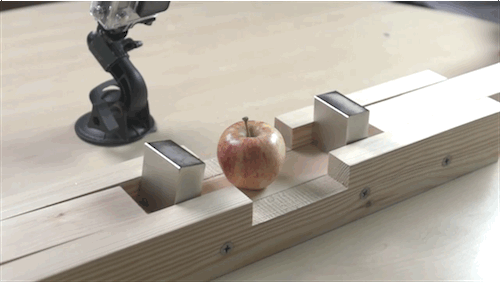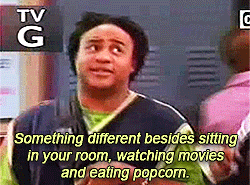Bethesda-physics-engine.gif
bethesda-physics-engine.gif

More Posts from Smparticle2 and Others
L.M. Montgomery, Anne of Green Gables (via books-n-quotes)
It’s been my experience that you can nearly always enjoy things if you make up your mind firmly that you will.

Making twisted semiconductors for 3-D projection
A smartphone display that can produce 3-D images will need to be able to twist the light it emits. Now, researchers at the University of Michigan and the Ben-Gurion University of the Negev have discovered a way to mass-produce spiral semiconductors that can do just that.
Back in 1962, University of Michigan engineers E. Leith and J. Upatnieks unveiled realistic 3-D images with the invention of practical holography. The first holographic images of bird on a train were made by creating standing waves of light with bright and dark spots in space, which creates an illusion of material object. It was made possible by controlling polarization and phase of light, i.e. the direction and the timing of electromagnetic wave fluctuations.
The semiconductor helices created by U-M-led team can do exactly that with photons that pass through, reflected from, and emitted by them. They can be incorporated into other semiconductor devices to vary the polarization, phase, and color of light emitted by the different pixels, each of them made from the precisely designed semiconductor helices.
Read more.











Chemists discover structure of bacterial enzyme that generates useful polymers
MIT chemists have determined the structure of a bacterial enzyme that can produce biodegradable plastics, an advance that could help chemical engineers tweak the enzyme to make it even more industrially useful.
The enzyme generates long polymer chains that can form either hard or soft plastics, depending on the starting materials that go into them. Learning more about the enzyme’s structure could help engineers control the polymers’ composition and size, a possible step toward commercial production of these plastics, which, unlike conventional plastic formed from petroleum products, should be biodegradable.
“I’m hoping that this structure will help people in thinking about a way that we can use this knowledge from nature to do something better for our planet,” says Catherine Drennan, an MIT professor of chemistry and biology and Howard Hughes Medical Institute Investigator. “I believe you want to have a good fundamental understanding of enzymes like this before you start engineering them.”
Read more.

Irving Langmuir, who won the 1932 Nobel Prize for ‘Surface Chemistry’, demonstrates how dipping an oil-covered finger into water creates a film of oil, pushing floating particles of powder to the edge.
The same phenomenon can be used to power a paper boat with a little ‘fuel’ applied to the back: as the film expands over the water, the boat is is propelled forward:

With experiments like this he revealed that these films are just one molecule thick - a remarkable finding in relation to the size of molecules.
In the full archive film, Langmiur goes on to demonstrate proteins spreading in the same way, revealing the importance of molecular layering for structure.
First, he drops protein solution onto the surface, and it spreads out in a clear circle, with a jagged edge:

Add a little more oil on top, and a star shape appears:

By breaking it up further, he makes chunks of the film which behave like icebergs on water:

You can watch the full demonstrations, along with hours more classic science footage, in our archive.

How to Make a Motor Neuron
A team of scientists has uncovered details of the cellular mechanisms that control the direct programming of stem cells into motor neurons. The scientists analyzed changes that occur in the cells over the course of the reprogramming process. They discovered a dynamic, multi-step process in which multiple independent changes eventually converge to change the stem cells into motor neurons.
“There is a lot of interest in generating motor neurons to study basic developmental processes as well as human diseases like ALS and spinal muscular atrophy,” said Shaun Mahony, assistant professor of biochemistry and molecular biology at Penn State and one of the lead authors of the paper. “By detailing the mechanisms underlying the direct programing of motor neurons from stem cells, our study not only informs the study of motor neuron development and its associated diseases, but also informs our understanding of the direct programming process and may help with the development of techniques to generate other cell types.”
The direct programming technique could eventually be used to regenerate missing or damaged cells by converting other cell types into the missing one. The research findings, which appear online in the journal Cell Stem Cell on December 8, 2016, show the challenges facing current cell-replacement technology, but they also outline a potential pathway to the creation of more viable methods.
“Despite having a great therapeutic potential, direct programming is generally inefficient and doesn’t fully take into account molecular complexity,” said Esteban Mazzoni, an assistant professor in New York University’s Department of Biology and one of the lead authors of the study. “However, our findings point to possible new avenues for enhanced gene-therapy methods.”
The researchers had shown previously that they can transform mouse embryonic stem cells into motor neurons by expressing three transcription factors – genes that control the expression of other genes – in the stem cells. The transformation takes about two days. In order to better understand the cellular and genetic mechanisms responsible for the transformation, the researchers analyzed how the transcription factors bound to the genome, changes in gene expression, and modifications to chromatin at 6-hour intervals during the transformation.
“We have a very efficient system in which we can transform stem cells into motor neurons with something like a 90 to 95 percent success rate by adding the cocktail of transcription factors,” said Mahony. “Because of that efficiency, we were able to use our system to tease out the details of what actually happens in the cell during this transformation.”
“A cell in an embryo develops by passing through several intermediate stages,” noted Uwe Ohler, senior researcher at the Max Delbrück Center for Molecular Medicine (MDC) in Berlin and one of the lead authors of the work. “But in direct programming we don’t have that: we replace the gene transcription network of the cell with a completely new one at once, without the progression through intermediate stages. We asked, what are the timing and kinetics of chromatin changes and transcription events that directly lead to the final cell fate?“
The research team found surprising complexity – programming of these stem cells into neurons is the result of two independent transcriptional processes that eventually converge. Early on in the process, two of the transcription factors – Isl1 and Lhx3 – work in tandem, binding to the genome and beginning a cascade of events including changes to chromatin structure and gene expression in the cells. The third transcription factor, Ngn2, acts independently making additional changes to gene expression. Later in the transformation process, Isl1 and Lhx3 rely on changes in the cell initiated by Ngn2 to help complete the transformation. In order for direct programming to successfully achieve cellular conversion, it must coordinate the activity of the two processes.
“Many have found direct programming to be a potentially attractive method as it can be performed either in vitro – outside of a living organism – or in vivo – inside the body and, importantly, at the site of cellular damage,” said Mazzoni. “However, questions remain about its viability to repair cells – especially given the complex nature of the biological process. Looking ahead, we think it’s reasonable to use this newly gained knowledge to, for instance, manipulate cells in the spinal cord to replace the neurons required for voluntary movement that are destroyed by afflictions such as ALS.”

Henry Cabot Lodge Jr. presenting “The Thing” to the Security Council at the United Nations. 26 May 1960.
via reddit
Keep reading





Spinal Stimulators Repurposed to Restore Touch in Lost Limb
Imagine tying your shoes or taking a sip of coffee or cracking an egg but without any feeling in your hand. That’s life for users of even the most advanced prosthetic arms.
Although it’s possible to simulate touch by stimulating the remaining nerves in the stump after an amputation, such a surgery is highly complex and individualized. But according to a new study from the University of Pittsburgh’s Rehab Neural Engineering Labs, spinal cord stimulators commonly used to relieve chronic pain could provide a straightforward and universal method for adding sensory feedback to a prosthetic arm.
For this study, published in eLife, four amputees received spinal stimulators, which, when turned on, create the illusion of sensations in the missing arm.

“What’s unique about this work is that we’re using devices that are already implanted in 50,000 people a year for pain — physicians in every major medical center across the country know how to do these surgical procedures — and we get similar results to highly specialized devices and procedures,” said study senior author Lee Fisher, Ph.D., assistant professor of physical medicine and rehabilitation, University of Pittsburgh School of Medicine.
The strings of implanted spinal electrodes, which Fisher describes as about the size and shape of “fat spaghetti noodles,” run along the spinal cord, where they sit slightly to one side, atop the same nerve roots that would normally transmit sensations from the arm. Since it’s a spinal cord implant, even a person with a shoulder-level amputation can use this device
Fisher’s team sent electrical pulses through different spots in the implanted electrodes, one at a time, while participants used a tablet to report what they were feeling and where.
All the participants experienced sensations somewhere on their missing arm or hand, and they indicated the extent of the area affected by drawing on a blank human form. Three participants reported feelings localized to a single finger or part of the palm.
“I was pretty surprised at how small the area of these sensations were that people were reporting,” Fisher said. “That’s important because we want to generate sensations only where the prosthetic limb is making contact with objects.”
When asked to describe not just where but how the stimulation felt, all four participants reported feeling natural sensations, such as touch and pressure, though these feelings often were mixed with decidedly artificial sensations, such as tingling, buzzing or prickling.
Although some degree of electrode migration is inevitable in the first few days after the leads are implanted, Fisher’s team found that the electrodes, and the sensations they generated, mostly stayed put across the month-long duration of the experiment. That’s important for the ultimate goal of creating a prosthetic arm that provides sensory feedback to the user.
“Stability of these devices is really critical,” Fisher said. “If the electrodes are moving around, that’s going to change what a person feels when we stimulate.”
The next big challenges are to design spinal stimulators that can be fully implanted rather than connecting to a stimulator outside the body and to demonstrate that the sensory feedback can help to improve the control of a prosthetic hand during functional tasks like tying shoes or holding an egg without accidentally crushing it. Shrinking the size of the contacts — the parts of the electrode where current comes out — is another priority. That might allow users to experience even more localized sensations.
“Our goal here wasn’t to develop the final device that someone would use permanently,” Fisher said. “Mostly we wanted to demonstrate the possibility that something like this could work.”
-
 quietbibliothecary liked this · 3 months ago
quietbibliothecary liked this · 3 months ago -
 star-platinum-vs-the-world reblogged this · 5 months ago
star-platinum-vs-the-world reblogged this · 5 months ago -
 herrdaumen liked this · 5 months ago
herrdaumen liked this · 5 months ago -
 anna0legovna reblogged this · 9 months ago
anna0legovna reblogged this · 9 months ago -
 anna0legovna liked this · 9 months ago
anna0legovna liked this · 9 months ago -
 shrimply-pebbles reblogged this · 10 months ago
shrimply-pebbles reblogged this · 10 months ago -
 shrimply-pebbles liked this · 10 months ago
shrimply-pebbles liked this · 10 months ago -
 jancer-lancer liked this · 1 year ago
jancer-lancer liked this · 1 year ago -
 marlanator22 liked this · 1 year ago
marlanator22 liked this · 1 year ago -
 fjord501 reblogged this · 1 year ago
fjord501 reblogged this · 1 year ago -
 fjord501 liked this · 1 year ago
fjord501 liked this · 1 year ago -
 edjicatrydau reblogged this · 1 year ago
edjicatrydau reblogged this · 1 year ago -
 duwango reblogged this · 1 year ago
duwango reblogged this · 1 year ago -
 duwango liked this · 1 year ago
duwango liked this · 1 year ago -
 brohos liked this · 2 years ago
brohos liked this · 2 years ago -
 vastsexual reblogged this · 2 years ago
vastsexual reblogged this · 2 years ago -
 miss-locked liked this · 2 years ago
miss-locked liked this · 2 years ago -
 insomnia-induced-mania liked this · 2 years ago
insomnia-induced-mania liked this · 2 years ago -
 tronmike82 liked this · 2 years ago
tronmike82 liked this · 2 years ago -
 eclairs-of-emptiness reblogged this · 3 years ago
eclairs-of-emptiness reblogged this · 3 years ago -
 fake-laflare liked this · 3 years ago
fake-laflare liked this · 3 years ago -
 violetsystems liked this · 3 years ago
violetsystems liked this · 3 years ago -
 violetsystems reblogged this · 3 years ago
violetsystems reblogged this · 3 years ago -
 cantown liked this · 3 years ago
cantown liked this · 3 years ago -
 kaito-1412 liked this · 3 years ago
kaito-1412 liked this · 3 years ago -
 plantkat reblogged this · 3 years ago
plantkat reblogged this · 3 years ago -
 thatoneguy1230 liked this · 3 years ago
thatoneguy1230 liked this · 3 years ago -
 modernmutiny reblogged this · 3 years ago
modernmutiny reblogged this · 3 years ago -
 sharden16 reblogged this · 3 years ago
sharden16 reblogged this · 3 years ago -
 child-of-oerba reblogged this · 3 years ago
child-of-oerba reblogged this · 3 years ago -
 avatar-style reblogged this · 3 years ago
avatar-style reblogged this · 3 years ago -
 avatar-style liked this · 3 years ago
avatar-style liked this · 3 years ago -
 plantkat reblogged this · 3 years ago
plantkat reblogged this · 3 years ago -
 thepallaspalace liked this · 3 years ago
thepallaspalace liked this · 3 years ago -
 sinnamonrollkitten liked this · 4 years ago
sinnamonrollkitten liked this · 4 years ago -
 trappedinavelociraptor liked this · 4 years ago
trappedinavelociraptor liked this · 4 years ago -
 vikicat5 liked this · 4 years ago
vikicat5 liked this · 4 years ago -
 theperpetualartist reblogged this · 4 years ago
theperpetualartist reblogged this · 4 years ago -
 one-in-a-maxi-million liked this · 4 years ago
one-in-a-maxi-million liked this · 4 years ago -
 youre-scaring-the-kids liked this · 4 years ago
youre-scaring-the-kids liked this · 4 years ago -
 asevril liked this · 4 years ago
asevril liked this · 4 years ago -
 heyoitsjen liked this · 4 years ago
heyoitsjen liked this · 4 years ago -
 sheepykins liked this · 4 years ago
sheepykins liked this · 4 years ago -
 sheepykins reblogged this · 4 years ago
sheepykins reblogged this · 4 years ago -
 gatmora reblogged this · 4 years ago
gatmora reblogged this · 4 years ago -
 gatmora liked this · 4 years ago
gatmora liked this · 4 years ago -
 peqchykeen reblogged this · 5 years ago
peqchykeen reblogged this · 5 years ago -
 peqchykeen liked this · 5 years ago
peqchykeen liked this · 5 years ago